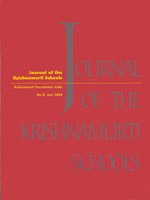Issue 8 - July 2004

- Written by J. Krishnamurti
I think most of us know what is happening in the world—the threat of war, the nuclear bomb, the many tensions and conflicts that have brought about new crises.
- Written by Kamala V. Mukunda
A tree derives its strength from its roots, striking deep into the earth, giving it stability and sustenance.
- Written by Editors
The question has often been asked of Krishnamurti schools as to how, in the absence of competition, reward and punishment, they educate students and help them to be proficient in academic learning.
- Written by Stephen Smith
Because our minds are crowded, we crowd our lives — with busy schedules, multiple activities, plans and projects for a better life.
- Written by Lalita Manjunath
“Look, a hare is jumping out of that bush!” “Let’s sit and quietly watch the snake coming out of its hole.” “Please help me get off this rock, aunty! I can’t find the grips!” “Hey, there’s a bird fallen on the ground.
- Written by G. Gautama
The youth of our times are in a special situation. The past four or five decades have unfolded into hitherto unknown situations in terms of culture and shifting beliefs.
- Written by Editors
The teaching and learning of history has been and will, by its very nature, be an area of much debate and controversy.
- Written by Venkatesh Onkar
When I look back at my history lessons in school, I am always intrigued by my own transformation from an utterly indifferent history student to an adult with a deep conviction that history is (perhaps) the most interesting and important subject ever.
- Written by P. Ramesh
The two-volume text entitled ‘Prehistory for Indian Schools’² relates the story of the origins of man as he came down from the trees, from his huntergatherer days down to his role as a shepherd and, finally, giving an account of the beginnings of agriculture which in turn helped man to move from a simple to a complex society.
- Written by Alok Mathur
Curriculum New ventures often begin with discontent. Social studies for class 6 had long been such a zone of discontent in our school.
- Written by Akhila Seshadri
In an age where there is constant manipulation of the senses, of decisions regarding lifestyle taking place, the young person is under constant threat to conform or else fall out.
- Written by O. R. Rao
This is a book* for many of those modern persons who hover on the brink of religion, those who wish to have faith but are unable to, and who say “Lord, I disbelieve, help thou my belief.” In a father-son dialogue recorded over a length of three hundred closely printed pages, the book exposes the basic questions involved in this perennial human predicament in its modern form.
- Written by V. R. Devika
The role and importance of folk performing artsThe folk performing arts have been traditionally used as vehicles of communication.
- Written by Kamala V. Mukunda
Eleven pairs of bright black eyes stare at me from eleven attentive faces, their pencils hovering over the page.
- Written by Editors
As teachers concerned about young people today, we composed some questions that we felt were crucial in helping us understand their processes of growing up.
- Written by Patrick Foster
Krishnamurti’s teachings seem more deep existential therapy than systematic philosophy.
- Written by Suprabha Seshan
Cool water, spilling over black stone. I stand still, watching vapors rise from your skin.
- Written by Dr. Ramachandran
Astronomy is probably the oldest of the sciences. It developed independently in many cultures.
- Written by Editors
“The purpose, the aim and drive of these schools, is to equip the child with the most excellent technological proficiency so that the student may function with clarity and efficiency in the modern world.
- Written by Bina Shivram
A report for a child in the kindergarten is a recording of the teacher’s observation of the child within a sensible framework.
- Written by G. Shoba
In the child’s initial years at school, parents and teachers together are responsible for creating an environment which is conducive for learning to take place.
- Written by Alok Mathur
The periodic task of writing end-of-term reports is like the visible ‘tip of an iceberg’ that comprises many layers and processes in school.
- Written by Usha Mukunda
“Is this a report meeting that I see before me?”
- Written by Ahalya Chari
These are the first three in a series of books designed to help the young to understand and deal with the world within themselves...
- Written by Editors
This is a charming fable written by a trained scientist and teacher, ‘for the child in everyone’ as the blurb says.
- Written by Editors
Do you love mathematics? Are you looking for suitable material that you can use to inspire your student of mathematics?

